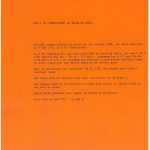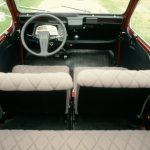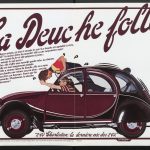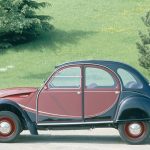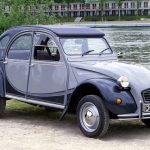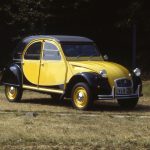
(english text see below)
Die Pressemitteilung der Citroën Deutschland GmbH vom 28. Oktober 2020:
Citroën 2CV Charleston feiert 40. Geburtstag
* Oktober 1980: Weltpremiere des Citroën 2CV Charleston auf dem Pariser Autosalon
* Limitiert: Auf 8.000 Exemplare begrenzte Sonderedition mit zweifarbiger Karosserie
* Erfolg: 2CV Charleston später Teil der regulären Modellpalette
* Ende: Letzte produzierte „Ente“ am 27. Juli 1990 war ein 2CV Charleston
Die Charleston-Ente wird 40! Im Oktober 1980 präsentierte Citroën auf dem Pariser Autosalon die Sonderserie „Charleston“ des 2CV, welche zunächst auf 8.000 Fahrzeuge limitiert war und 24.800 Francs kostete. „Um die 2CV-Puristen zufriedenzustellen, sind die Scheinwerfer rund, mit einem roten Gehäuse“, so wurde die limitierte Edition in der damaligen Pressemitteilung beschrieben. Mit seinem schicken und unkonventionellen zweifarbigen Design, den Sitzen mit Hahnentritt-Bezug und den runden Scheinwerfern stellte der 2CV 6 Charleston die außergewöhnlichste Version des 2CV dar und reihte sich nach dem 2CV Spot aus dem Jahr 1976 erfolgreich in die neu aufkommenden, begehrten limitierten Editionen ein.
Durch die große Nachfrage der limitierten Sonderedition wurde der Charleston dann ein Jahr später, im Juli 1981, in die Standardproduktion aufgenommen. Hergestellt im Werk Levallois bei Paris, unterschied sich die neue Variante von der limitierten Edition durch verchromte Scheinwerfer und graue Velours-Polsterungen mit Rauten-Muster. Anfänglich war der 2CV 6 Charleston ausschließlich in der Farbkombination Delage Rot/Schwarz erhältlich und wurde später durch die Hélios Gelb/Schwarz-Kombination ergänzt, welche jedoch im Juli 1983 durch Nachtgrau/Kormorangrau ersetzt wurde.
Ab 1988 wurde die Produktion im Werk Mangualde in Portugal fortgeführt. Die an diesem Standort hergestellten Fahrzeuge sind an ihren Fenstern zu erkennen, die den Namen des spanischen Glasers „Covina“ tragen. Am 27. Juli 1990 um 16.30 Uhr lief dann schließlich die letzte „Ente“ in Mangualde vom Band: ein 2CV 6 Charleston in Nachtgrau und Kormorangrau. Insgesamt wurden 5.114.969 2CV inklusive Derivate gebaut.
Der 2CV zählt nach wie vor zu den Ikonen der Automobilgeschichte und erfreut sich einer großen Sammlerszene auf der ganzen Welt. Zu diesem herausragenden Erfolg hat auch der Charleston maßgeblich beigetragen.
Heute werden für einen gut erhaltenen, fahrbaren 2CV 6 Charleston in der originalen limitierten Edition Preise um die 14.500 Euro erzielt, die Standardversion kostet rund 10.500 Euro. In der Citroën Lifestyle Boutique können Charleston Miniaturen zu 5 Euro und Charleston Schlüsselanhänger zu 4 Euro erworben werden.
Überblick über die insgesamt 12 limitierten 2CV Sonderserien, die in europäischen Ländern auf den Markt gekommen sind:
Frankreich
1976: 2CV Spot
1980: 2CV Charleston
1981: 2CV 007 James Bond
1983 und 1984: 2CV France 3
1985 und 1986: 2CV Dolly
1986: 2CV Cocorico
Spanien
1982: 2CV Marcatelo
Deutschland und Schweiz
1983: 2CV Transat
1985: 2CV Ente Grün „I fly bleifrei“
1987: 2CV „Sausss-Ente“
England
1987: 2CV Bamboo
Belgien
1988: 2CV Perrier
Anlässlich des 60-jährigen 2CV Jubiläums kam 2008 das Cabriolet C3 Pluriel Charleston als limitierte Sonderserie in den charakteristischen Farben Delage Rot/Schwarz auf den Markt.
Weitere Informationen zum 2CV und anderen historischen Citroën Modellen unter: www.citroenorigins.de
Technische Daten 2CV Charleston
Länge: 3,83 m
Breite: 1,48 m
Höhe: 1,60 m
Spurweite: 2,40 m
Anzahl der Sitze: 4
Motor: A06/635
Hubraum: 602 cm3
Bohrung: 74 mm
Hub: 70 mm
Verdichtungsverhältnis: 8,5
Drehmoment: 4 mkg bei 3.500 U/min
Kraftstoff: Benzin
Steuerpflichtige Leistung: 3 CV
Tatsächliche Leistung: 29 DIN-PS bei 5.750 U/min
Reifen: 125/15
Leistungsgewicht: 17,0
Leergewicht: 560 kg
Vordere Bremsen: Trommelbremsen, ab 1982 Scheibenbremsen
Hintere Bremsen: Trommelbremsen
Handbremse: Mechanisch (Vorderradbremse)
Kontakt:
Christopher Rux
Leiter Presse und Öffentlichkeitsarbeit
Citroën Deutschland GmbH
+49 151 628 14 296
christopher.rux@citroen.com
—–
40TH ANNIVERSARY OF THE CITROËN 2 CV CHARLESTON
The international press release of Automobiles Citroën / Date of publication : 27/10/2020
* In October 1980, Citroën presented the 2 CV 6 Charleston at the Paris motor show.
The brand-new special edition was limited to 8,000 units, and was so successful that it was added to the range catalogue in July 1981, until the 2 CV reached the end of production.
* The last 2 CV produced was also a Charleston, released on 27 July 1990.
* While the period won’t be featured in any rallies, it’s still possible to (re)discover the 2 CV and admire its chic, quirky character and two-colour exterior 40 years after its launch.
Forty years ago, in 1980, Citroën launched a special series of 8,000 units dubbed “Charleston”, at a price of 24,800 francs. As noted in the press release issued at the time, “to satisfy the 2CV ‘purists’, the headlights are round, with a red housing.”
With its chic and quirky style, the 2 CV 6 Charleston embodied the highest degree of finish and power ever seen on the 2 CV. After the Spot in 1976, the 2 CV 6 Charleston rode a new wave of limited editions.
Though its finish was borrowed from the Club, the 2 CV 6 Charleston stood out with its special upholstery and round headlights, like those on the 2 CV Spécial.
The following year, in July 1981, the limited series was so successful that it became unlimited: now mass-produced at the Levallois plant, the model was added to the Citroën catalogue. This version differed from the limited edition with its chrome headlights and grey, diamond-pattern upholstery.
Initially sold in Delage Red and Black, it later came with a Hélios Yellow and Black variant in July 1982, which was then replaced in July 1983 with a version painted in two shades of grey, Night Grey and Cormorant Grey.
Production continued in 1988 at the Mangualde plant in Portugal. The models produced at this site can be identified by their windows, which bear the name of the Spanish glazier, “Covina”.
On 27 July 1990, at 4:30 pm, the last 2 CV to leave the Mangualde production line was a Night Grey and Cormorant Grey 2 CV 6 Charleston. This was the 5,114,969th and the last 2 CV produced.
The 2 CV remains an icon of automotive history and a favourite of numerous collectors around the world. The Charleston contributed to this success over the last 10 years of production.
Today, for a drivable version in good condition, the 2 CV Charleston lists for about €14,500 in its original limited edition, and €10,500 for the catalogue version.
It is still possible to acquire one in the form of a three-inch miniature (€5) or key chain (€4), sold in the Lifestyle Citroën shop. The Charleston is a popular choice, as one out of every five 2CV miniatures sold is a Charleston!
The historic 2 CV boasts 10 special editions launched in France and certain European countries:
France:
1976: 2 CV Spot
1980: 2 CV Charleston
1981: 2 CV 007 James Bond
1983 and 1984: 2 CV France 3
1985 and 1986: 2 CV Dolly
1986: 2 CV Cocorico
Spain:
1982: 2 CV Marcatelo
Germany and Switzerland:
1985: 2 CV Ente Grün
England:
1987: 2 CV Bamboo
Belgium:
1988: 2 CV Perrier
In 2008, for the 60th anniversary of the 2CV, a limited-edition Charleston was launched based on another model from the Citroën line, which was also a convertible: the C3 Pluriel Charleston, with the same Delage Red and Black exterior.
For further information:
* Citroën Origins, the brand’s virtual museum, offers an immersive experience with 3D images (interior/exterior) and sounds from aboard the 2 CV and 80 other iconic Citroëns: www.citroenorigins.com
* See the story of Howard, the owner of a 2 CV Charleston in the United States. In 2019, the year of the brand’s 100th anniversary, Citroën featured fans from around the world with its series Citroën Générations:
http://www.citroenorigins.fr/fr/landing/citroen-generations
* Citroën Lifestyle Shop: www.lifestyle.citroen.com
THE 2CV CHARLESTON, A DECIDEDLY RETRO CHARM
The 2 CV 6 Charleston has all the charm and simplicity of the 2 CV, but adds an additional touch a playfulness and elegance that fits in seamlessly. Its inimitable two-colour exterior, whose tones are separated by a rounded border, hearkens back to the original 2CV prototype from 1939. The darker colour covers the underbody panels, the wings, and the roof up to the top portion of the windscreen. The lighter colour covers the boot door, the bonnet, the bay, and the contours around the windscreen, as well as the wheels. A border composed of two white stripes curves over the top of the windows, while above, a chrome clip covers the groove around the doors. While the limited edition Charlestons were given Delage Red headlamps, the mass-produced models had chrome lamps. The bumpers are painted metallic grey, and a square-shaped, monogram sticker with the name of the model inscribed appears on the boot door. The underbody panels are equipped with chrome clips, while the hubcaps, which are borrowed from the Dyane, likewise come in chrome. Echoing the finish of the 2 CV 6 Club, the dashboard features a large speedometer and rectangular push buttons to activate the windscreen wipers, the hazard lights and the brake fluid indicator. A single-spoke steering wheel has also been featured on high-end 2CVs since 1976. Two sun visors are installed, including one with a vanity mirror for the passenger. Behind them are two small hooks used to unlock the convertible top so that it can be opened from the inside.
The door interiors are lined with grey fabric, and a black plastic panel, moulded with a handle to help with closing the door, surrounds the door handle and masks the closure system. The limited edition 2 CV 6 Charleston features a broken-check pattern on its upholstery, while the mass-produced version features grey upholstery decorated with diamond-shaped patterns.
Unlike the 2 CV 6 Club and Spécial, the centrifugal clutch option is unavailable. Upon its release and throughout its career, the engine on the 2 CV 6 Charleston never went through any notable changes. In this case, the engine it came with was an A06/635, with a rating of 29 DIN hp at 5750 rpm. This performance was achieved by adding a Solex 26/35 CSIC twin-body carburettor in 1978. Otherwise, the 602cm3 engine, installed in February 1970, retained its main characteristics. The bore and stroke are still 74×70 mm, providing a compression ratio of 8.5 and a torque of 4 mkg at 3500 rpm. The 12V electrical equipment includes a 28A alternator connected via belt to a pulley that drives the nine-blade cooling fan. The suspension extends between the front and rear wheels, which are equipped with coil springs. The drum brakes at the front and rear are controlled by a simple master-cylinder.
DATA SHEET
Length: 3.83 m
Width: 1.48 m
Height: 1.60 m
Track width: 2.40 m
Number of seats: 4
Engine: A06/635
Cylinder capacity: 602 cm3
Bore: 74 mm
Stroke: 70 mm
Compression ratio: 8.5
Torque: 4 mkg at 3500 rpm
Fuel: Petrol Taxable
horsepower: 3 CV Actual
horsepower: 29 DIN hp at 5750 rpm
Tyres: 125/15
Weight-to-power ratio: 17.0
Curb weight: 560 kg
Rear brakes: drum brakes, then disk brakes after 1982
Front brakes: drum brakes
Hand brake: Mechanical (front brakes)
TRANSLATION OF THE CITROËN PRESS RELEASE FROM 12 SEPTEMBER 1980
THE 2 CV CHARLESTON AT THE PARIS MOTOR SHOW
On 1 October 1980, Citroën will introduce a special series of 8,000 2CVs, known as the 2 CV “Charleston”.
The 2 CV Charleston, which will be presented at the Paris motor show, is a 2 CV 6 Club (602 cm engine – 29 hp – 115 km/h – fuel consumption: 5.4 L/100 km at 90 km/h, and 6.8 L of urban consumption) with a red and black body and grey adhesive ornaments.
To satisfy the 2CV “purists”, the headlights are round, with a red housing.
The wheels are red-coloured, with hubcaps from the Dyane 6.
The front seats and rear bench seat are covered in black and white fabric with a broken check pattern.
This special series will be sold in France and Europe.
Drive-away price (all taxes included): 24,2480 francs.
PRESS CONTACTS
Nathalie ROUSSEL – Tel: +33 (0)6 87 77 41 82 – nathalie.roussel@citroen.com
Shaneez SUDOOLLAH – Tel: +33 (0)6 25 52 24 33 – shaneez.sudoollah@citroen.com
The Citroën brand
At the heart of the automotive market, Citroën has been a popular brand in the noble sense of the word since 1919, its main source of inspiration being people and their lifestyles. This spirit is underlined by its “Inspired by You” signature and embodied by cars boasting unique styling and benchmark comfort. Citroën also stands out among mainstream car manufacturers by bringing its customers a unique experience, for example with Citroën Advisor and “La Maison Citroën”. In 2019, the Brand sold 1 million vehicles in more than 90 countries.
Citroën media site: https://int-media.citroen.com

